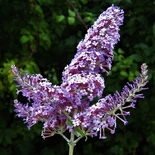Nothing draws people’s ire as quickly as suggesting that they not plant buddleia in a butterfly garden.
It’s understandable that people plant buddleias (Buddleia davidii or B. alternifolia; sometimes spelled Buddleja). After all, most garden books and websites include them in their lists of butterfly garden plants. And it’s easy to see why people like them: They’re colorful butterfly magnets.

Orange Eye Butterflybush(Buddleja davidii)
I used to have almost a dozen butterfly bushes (buddleia’s common name, summer lilac is another). I enjoyed watching butterflies drawn by buddleia’s abundant nectar. In fact, after buying the first one, I grew more each year. They were so easy to start from seed. That’s the problem. Not only do they grow easily from the seed you intentionally plant, but they also generously volunteer in your yard and beyond.
Invasiveness
Not a problem in the north? Despite the fact that some say they have trouble overwintering them, this has not been my experience here in central New York – one of the colder, more wintry areas of the country. My buddleias had faithfully returned each year. Last summer I became convinced of their potential invasiveness when I found a small butterfly bush ready to flower. It was growing in the shade, six years after I had eradicated all my butterfly bushes.
But this didn’t happen just in my yard. Native to China, and introduced to North America about 1900, buddleia now is found throughout the eastern, southern, and western states. It also has displaced native species all over Europe, even becoming a safety risk along railroads. And it’s a major problem in New Zealand.
Resistance
Why then is there such resistance to the suggestion that it not be planted? At the heart of this attachment to buddleia may be one’s calculation of environmental risks, and perhaps one’s relationship to our gardens and the natural world.
It’s true that many who plant buddleia may not yet see it invading nearby natural areas. But when its invasive potential is documented in similar areas, is it wise to wait for it to become a problem in our own area before we stop planting it? If only we had stopped planting multiflora rose, kudzu, or similarly destructive invasives when their invasive tendencies were first noted. Experience shows that some invasive plants that had seemed relatively well-behaved for decades after introduction have suddenly exploded out of control. Furthermore, global warming appears to be favoring the spread of invasive plants northward, with the result that we can no longer depend on cold winters to keep these plants in check. Abiding by a “precautionary principle” that treats such problematic plants as guilty until proven innocent, not the reverse, seems to be the wisest choice – the choice most likely to leave a healthy planet for our children and grandchildren.
The passionate response this plant evokes is perhaps also because people enjoy watching wildlife and they like to help wildlife – both laudable activities. But in my own gardening life, I try to distinguish between attracting wildlife, and providing for wildlife. I do sometimes attract wildlife – for example, by providing birdfeeders. However, I try to make most gardening decisions based on what provides healthy habitat for wildlife now and in the future, not just for my current enjoyment. Butterflies like buddleias, and it is fun to watch them flock to the plants, but given the destructive nature of invasive plants in the larger ecosystems, is including buddleias ultimately the healthiest choice for wildlife? As the amount of truly wild areas relative to managed areas diminishes, we’ll be increasingly faced with similarly consequential decisions.
Creating butterfly habitat
The good news is that butterflies will visit your yard even without buddleia. Don’t forget that providing appropriate food plants for the caterpillars – not just nectar plants for the adult butterflies – is key to creating butterfly habitat.
Conclusion
There’s no reason to plant buddleias when there are so many other native plants that also provide nectar for butterflies without the risk of degrading our natural areas. But while you’re waiting for an opportunity to replace any buddleias in your yard, please minimize the risk by faithfully deadheading spent flowers.
Don’t confuse butterfly bush (Buddleia spp.) with the native butterfly weed (Asclepias tuberosa). Butterfly weed is a milkweed, and therefore a larval host plant for the monarch butterfly. And it’s a good nectar plant in general.

